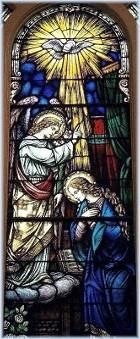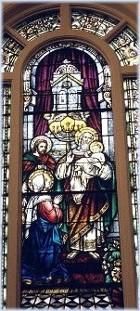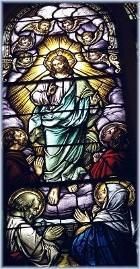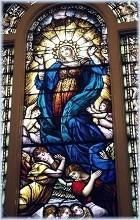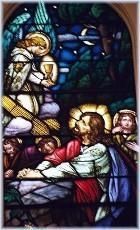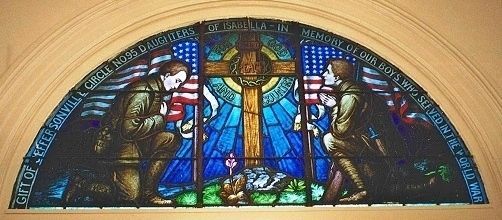St. Augustine Catholic Church History
A Brief History of St. Augustine Church
The property on which St. Augustine stands today was purchased in the mid-1850s by Father Augustus Bessiones, who was the first resident priest in Jeffersonville. The church's foundation was laid in 1864, and construction continued for several years. By 1869 the bell tower and the front of the church were finished. The church was named St. Augustine in honor of Father Augustus Bessiones.
Read More
August 10, 1851
The property on which St. Augustine stands today was purchased in the mid-1850s by Father Augustus Bessiones, who was the first resident priest in Jeffersonville. The church's foundation was laid in 1864, and construction continued for several years. By 1869 the bell tower and the front of the church were finished. The church was named St. Augustine in honor of Father Augustus Bessiones.
The parish obtained a large pipe organ, a main altar, two bells, and a wood-carved pulpit. In the middle of the church hung a large chandelier, and all the windows were plain, not stained glass. The church was slightly damaged by the flood waters of 1883-84 when water reached as high as the second step of the main altar.
As the congregation grew, a remodeling of the structure began to take place. Steam heat, stained-glass windows, electric lights, and a new main altar were all added, and the walls were frescoed.
On December 9, 1903, during the remodeling period it is believed a careless worker dropped a match which started a fire, and in a day's time only the walls and bell tower were left standing. The loss was estimated at $40,000. By the spring of 1904 what was left standing was torn down and a new building was built. The style of architecture for the new church was Spanish Renaissance. It is believed that much of the new construction was done by the parishioners.
On June 18, 1905, the parishioners were able to celebrate Mass in the partially completed structure. In 1910 three new bells, weighing 2 1/2 tons, were placed in the large tower, and a manual pipe organ was purchased and installed in the church balcony.
The bells were named:
Joannes (the small bell), John -- with the inscription: Laudate pueri dominum "Children, Praise the Lord"
Jacoeus (the medium bell), James -- with the inscription: Laudate Dominum omnes gentes "All peoples praise the Lord"
Augustinus (the large bell), Augustine -- with the inscription: Gloria in excelsis Deo "Glory to God in the highest"
In 1913 a major renovation of the church was undertaken after the parish received a donation of $15,000 for the marble from Mr. John Morgan. The marble was ordered from Italy, and there was concern that because World War I was in progress that the ships could be sunk bringing the marble from Italy. The marble did not arrive until 1924.
Workers were sent from Italy to help put everything together. The main altar, two side altars, communion rails, pillars, and statues were constructed of marble, but the wainscoting and Stations of the Cross are not marble. Marble terrazzo was added to the sanctuary floor.
A unique piece is the sculpture of the Lord's Last Supper above the back altar. The sculpture was done by Amedo T. Nardini of Carproni Galleries in Amedo, Italy. The church floor had to be shored up due to the weight of the marble.
The stained-glass windows, depicting the Mysteries of the Rosary, were added in the early 1920s. These windows, manufactured by the Emil Frei Company of Munich, Germany, were placed inside the original clear glass windows, giving added insulation from the weather. The new altars and redecorated church were consecrated on March 25, 1925.
A new marble pulpit was donated to the church by O.H. Wathen just in time for the 1937 flood of the Ohio River, when waters reached the top of the main altar.
Since 1973 the church, as well as the parish, has experienced many changes and improvements. These include a new organ, a new boiler, air conditioning, insulation, ceiling fans, light fixtures, new paint, and a platform new front altar which brings the congregation and the priest together as one in the celebration and worship. This was done in accordance with new liturgical guidelines handed down from Vatican II.
In 1983 another major renovation project was completed. The church roof was repaired, the inside of the church was carpeted, and new pews were installed. The interior and the Stations of the Cross were painted.
The "old" sacristy became a Blessed Sacrament chapel, allowing for small liturgies and a quiet place for prayer. The marble pulpit was restructured and moved next to the altar. Sections from the communion rail were utilized in the design and construction of the new altar.
In 1995 a new speaker system was added. In 1997 repairs were made to the roof, a sprinkler system was installed, and extensive replastering was completed. The interior was also painted, the marble was cleaned, and new carpeting was installed.
In 2014, a complete interior renovation took place, including installing a new baptismal font, cleaning of all the marble, and new paint and carpeting, which enhanced the church's appearance for a new generation. A few years later, the air conditioning and sound system was upgraded. In 2022, the stained glass windows were refurbished and the parish hall underwent a complete interior renovation, including an updated commercial kitchen.
Taking note of the struggles and sacrifices necessary to build the house of the Lord, we appreciate the interest and support of various churches and congregations who have experienced similar struggles.
The more than 150-year history of St. Augustine Church has been a story of tests and trials to establish a house of worship. As Christians, we await the "Day of the Lord" with patient endurance, carrying our cross at times and realizing that tests are God's way of "creating us anew."
We have suffered through a fire and two floods; however, God's goodness and glory eventually shine through. God has certainly been good to the Catholic Community of St. Augustine.
We are happy to share God's goodness with you. We are pleased to share our heritage which is manifest in this church building. We thank you for the time you have shared with us.
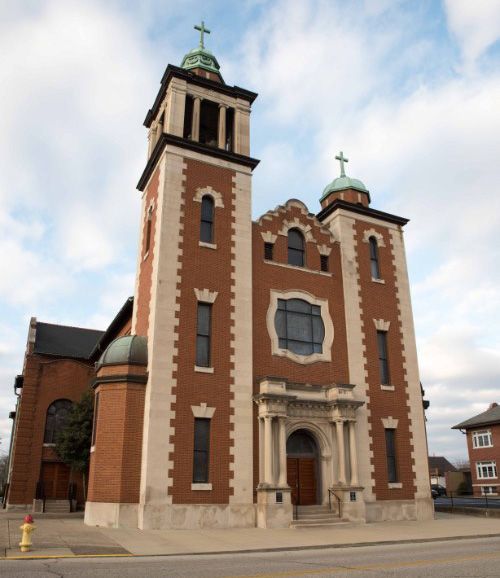

History of St. Augustine School
Read More
And for the first time in the 100 years of the school’s existence, classes would not resume when the students returned in the fall of that same year.
The year 2009 marked the 140th anniversary of the humble beginning of St. Augustine School. We took this opportunity to try and catch a small glimpse of St. Augustine’s Parish history, as it pertains to the school and its spiritual heritage.
We all know that the Lord works in mysterious ways, and I have yet another testimony to this fact. I was having trouble getting started on this story. I was stressing over where I was going to get my factual information. So, out of desperation, I decided to go through some old family pictures and articles that I keep in a drawer, hoping to come across something that would help me in my struggles. As I was sifting through decades of family artifact, there it was, the 1975 Directory of St. Augustine Catholic Church, and contained within it, the history of our church beginning in 1851 to the date of its publication. By a stroke of luck or divine intervention, I had found the exact instrument I was searching for, and I had no idea that it was even there! So, with this being said, all the dates and information pertaining to those dates that follow, have been taken from this terrific directory.
In the beginning...
In 1869, Father Audran, the pastor, invited the Sisters of Providence to open a school at St. Augustine. Classes were initially held in the priest’s residence. Shortly thereafter, an adjoining residence was purchased and served as a girls’ school and convent. In 1872, a two story brick building was built in the rear of the church and was used as the school for the boys of the parish.
On August 23, 1915, under the direction of Father Halpin, a new school building was started that would eventually house eight classrooms, three offices, a large upstairs auditorium, a kitchen, banquet hall, play-room, club rooms, and a bowling alley for the men of the parish (bowling alley?). In May of 1924, the Sisters of Providence left St. Augustine and by the fall of this year the Dominican Sisters were running the school . The Dominicans, of course, wore the full habits with the starched headdress and the long beads attached to a wide black belt, which you could hear rattling a block away, recalls my oldest brother Danny Burke, who graduated from St. Augustine ’s in 1952. "We went to Mass daily, and there were no discipline problems during Mass!" Danny went on to say.
In the fall of 1942, Father Albert Deery was appointed pastor. Six years later, our neighbor parish, St. Anthony’s, built a new church and school in Clarksville, causing many of their parishioners to transfer to St. Augustine and thus creating an increase in membership at our parish and increasing the enrollment in our school. By 1953, over 100 pupils were enrolled in first grade. In 1954, another parish was ordered to be built in the eastern part of Jeffersonville by Archbishop Schulte in order to help ease the growing membership burden. Father Robert Walpole founded this new parish, which was to be named for and dedicated to the honor of the Sacred Heart of Jesus.
But, by the early to mid-sixties, St. Augustine’s found itself in the midst of changing times. By 1968, with two new sister parishes only a few miles away, a new interstate highway running through downtown, and the beginning of urban flight, the school found itself with only 158 students in all eight grades by. As a result of this declining enrollment, at the end of the following school year, in 1969, the school closed its doors for the final time. And in the summer of 1975, the school had fallen into disrepair and was taken down.
I had just finished my third grade year in the spring of 1969. With the closing of the school, I would be the only one of my ten siblings who would not have the honor of graduating from St. Augustine. It is still hard to imagine the school building as it stood: long and narrow, three stories tall and right along the alley way. Many times over the past several years, I have tried to describe to my boys how the school fit into such a small space. I vividly remember the tunnel like archway connecting the church and school, and how it had an almost mysterious medieval feel when walking through it. I still remember the outside fire escape, the large interior staircase, the gymnasium/auditorium, and the low ceiling. The St. Augustine gym, on the third floor, had a low ceiling, recalls my brother, "This caused the shooter to flatten the arch of his shot," Danny said.
I have often times thought about the many nuns (and lay teachers) who passed through the hallowed halls of St. Augustine School over the 100 years of its existence. Their dedication to their teachings, their faith, to this parish, and to the many families and students whose lives they affected in so many ways continues to be felt to this day. I remember them all being excellent teachers and very pious, and they grounded us so well in our Catholic faith. "To this day, I can recall many of their teachings," said Danny Burke.
As for those of us who had the privilege to attend St. Augustine School, as we look back and remember, I ask that you share your memories. You can reach me by e-mail at burke3412@sbcglobal.net.
Through These Doors Pass Saints and Scholars
These words formed a sign that hung over the entry way of St. Augustine School for all to see and as a reminder of what was probably and unknown to us at the time, our school‘s mission statement
In this, the second and final part of this series, we once again take a look back to our historic past, recalling and reliving some of our most vivid memories as we celebrate the 140th anniversary of our school and its heritage. To follow are a few of those memories that some of you have been gracious enough to send and share with our Catholic community.
"Six of us went through St. A‘s with Karen being the class that ended it all!" recalls Teresa Popp, referring to the Knight family. "We all have so many of them (stories), but one sticks in my mind. I had started school as a young first grader, just turning six. I ran away on the second day through that alley that you talked about trying to get home as fast as I could. I was taken back with a lot of tears. I did not want to be in school. I soon got the chicken pox and missed some school, so Mom took me out and started me the next year hoping I'd be ready," Teresa went on to say.
Sometimes school was actually fun!…What is now the main and original church parking lot, served a dual role during those years of the school‘s vitality. It was used as the school yard / playground for recess by many a generation. I vividly recall swinging on the steel poled swing set harbored under the big trees and facing Chestnut St . We would swing as high as possible, feeling as if we were half way over the street at the peak of our flight. I remember getting home from school, jumping on my bike and re-turning to school just to swing.
I recall some pretty intense kick ball games in the school yard as well. And even though there was not a basketball goal on the grounds, Tony Heavrin, Doug Lewis and I made the "No Parking" sign posted over Father‘s garage our make-believe hoop, as we got off one spectacular shot after another! When recess was over, Sister was there, ringing the big shinny brass bell, and we would all scamper to get in line and head back to our respective class rooms. Once inside, we would take our coats to the enormously large walk through closets, maybe better known to some as the cloakroom.
Virginia McBride writes, ―I‘m in the picture at the beginning of this article – think there are still eight of us living – can still identify more than half in the picture. St. Augustine‘s was a great school and the Dominican nuns were the icing on the cake …The school seemed monstrous. I can remember first Friday‘s were Corporate Communion days with hot chocolate and donuts to follow. She goes on to say, ― Students couldn‘t wait to be an eighth grader and have Sr. Richarda, our principal, as a teacher. Eighth graders were allowed to come to the classrooms to sell candy with underclassmen as an aide … such a treat to be chosen to be an aide, said Mrs. McBride.
― One of the things that stands out to me about the school was that even though it was pretty small, it seemed huge to me as a student, recalls Jimmy Boone (Class of 67). ― The halls seemed huge, the classrooms, the windows, everything, even the playground. I guess it had something to do with the fact that there were 10 of us in a relatively small house growing up on 7th Street. I was the fifth of seven kids and the last to graduate from St. A's. (Side note: Between the Boone and Burke families, 17 children attended St. Augustine School). I also remember the plays that we produced on the stage that adjoined the gym upstairs. The firemen had to come up to the gym beforehand to make sure that it could withstand the weight of all the parents and family that would attend. That was kind of scary not knowing if the floor would hold up. But, thank God, it did, Jim said. (Guess it was good thing that the bowling alley wasn‘t up there!)
Not all our memories are pleasant ones, but none the less, they are part of what we remember … I was a 7th grade student in November 1963, recalls Chick Elliott. There was a knock on my seventh grade classroom door. It was Sister Rosella, the principal. She came into my class and whispered something to my teacher. My teacher immediately became visibly upset and started crying. An announcement was made shortly after that saying that President John F. Kennedy had been shot. School was dismissed and I remember going home and watching TV all day with my family who was also upset, said Chick.
"Then there was the ‘37 flood," remembers Virginia McBride. "In those days there was much stress put on Palmer Penmanship – the eighth graders had completed our exercises and were awaiting our Palmer Diplomas, but the Ohio River took care of that," she said.
We never forget those who so strongly influence our lives … I remember Sister Maria Del Socorro being the sweetest nun I ever had. She made me a helper and I stayed after school to help her get ready for the next day, putting crayons and papers on the desks and just talking with her. I am 55, but I can remember being six years old and feeling so loved by her. She was gentle and kind to a little girl who was still not sure about this school thing. Because of her, I began to love school, Teresa (Knight) Popp recalls passionately.
Now, you know we couldn‘t complete this story without mentioning our Cubs and our sport teams … Sports at St. Augustine 's was, I think, pretty unique. Even though we were small in numbers enrollment wise, we were always competing for a Deanery championship in all sports, be it basketball, football, track or cross country, states Jimmy Boone. Jim goes on to say, We were blessed with great coaches who volunteered many hours to work with the small numbers that we had. There was a period of about 6 or 7 years when we didn't have enough to field a football team, and those who did want to play had to play for St. Anthony. But by the time of my eighth grade year (1966-67), we barely had enough to field a team and came one game away from the Deanery Championship. In basketball we were small but fundamentally sound, thanks to Coach Ron Fifer, and always fought and always had a good won-loss record. In track and cross country, we were very good. In fact, when I was in 7th grade, our 7-8th grade team won the Deanery cross country meet by having our runners place 1st, 2nd, 4th, 6th, 7th, 8th and 10th out of probably 50 runners. GO CUBS, said Jimmy.
Thanks to all who shared their stories as we attempted to catch just a glimpse of the past of our hallowed school.
"SAINTS and SCHOLARS" and all those in between … On the 140th anniversary of our school, we remembered.
A Look Back at St. Augustine School
by Kevin Burke
When the bells rang throughout the halls of St. Augustine school on the last day of classes in the spring of 1969, it signified not only the end of another school year, but it also signified the end of an era as the school closed its doors for the final time.
St. Augustine of Hippo
Feast day: August 28th
A Christian at 33, a priest at 36, a bishop at 41: many people are familiar with the biographical sketch of Augustine of Hippo, sinner turned saint. But to really get to know the man is a rewarding experience.
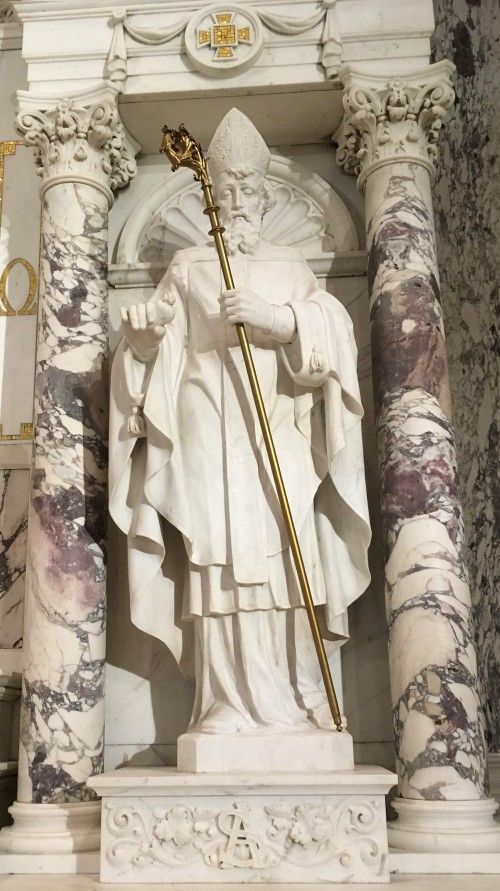

St. Augustine Memorial Garden
Since the dedication of the Memorial Garden, there have been many happenings to commemorate in our lives: babies born, couples married, anniversaries celebrated. Sadly, some of us have had deaths to celebrate also. We have a wonderful way to help you commemorate these memories, happenings and celebrations in our parish.
Read More
The memorial Garden is there for those who want to provide an enduring memorial for their special occasion. Could there be a finer way than to purchase a two or three line prayer brick in the Memorial Garden? Perpetual remembrance of love ones and/or beloved occasions also make a unique gift.
If you haven't yet spent a few quiet moments at the garden for prayer or for contemplation, you would be surprised how gratifying an experience it can be.
If you would like to order a brick for the Garden floor, you can find order forms in the back of church at the Information Window.

